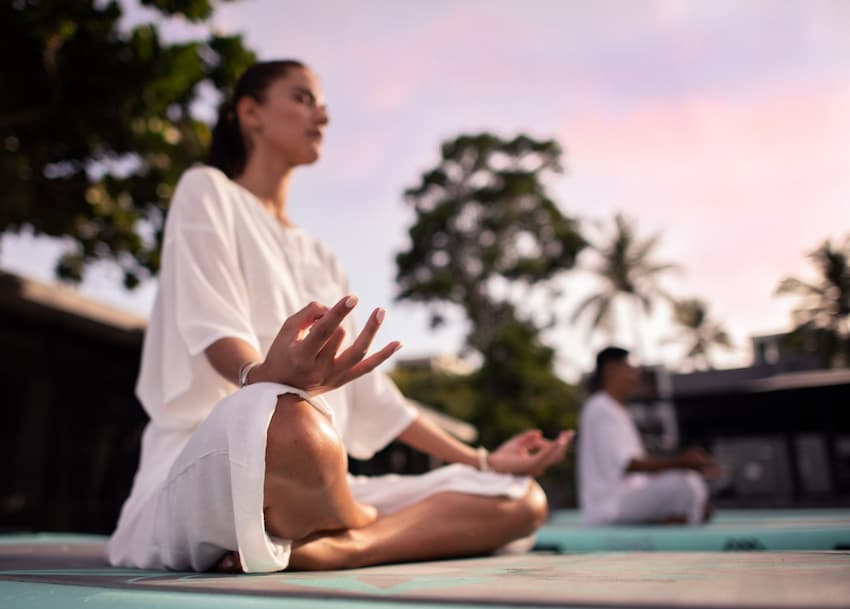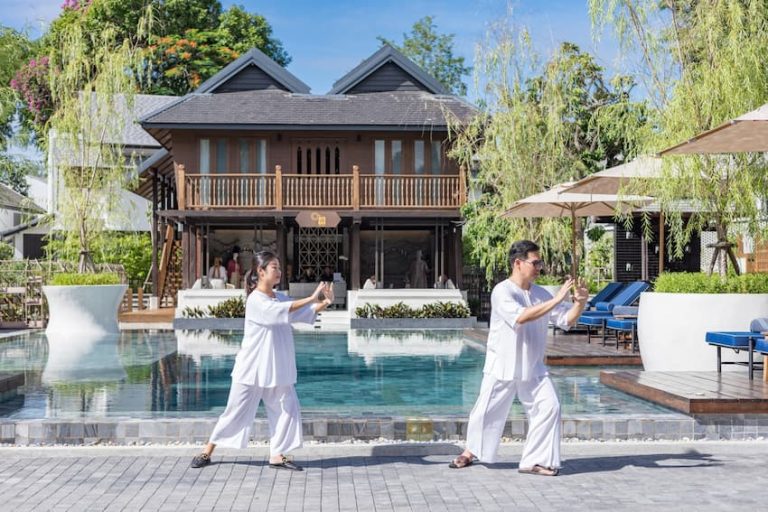Yoga Nidra, often called yogic sleep, is a meditation and conscious relaxation practice rapidly gaining recognition for its profound benefits. This practice, originating from ancient yogic teachings, has resurgent in recent years as individuals worldwide look to reduce stress and enhance their overall well-being. Central to Yoga Nidra is the concept of reaching a state of deep relaxation while maintaining full consciousness, distinguishing it from typical meditation practices.
While Yoga Nidra is accessible to beginners, there exists a spectrum of practices that cater to all experience levels, including advanced techniques designed to deepen the relaxation experience. These advanced practices go beyond the initial stages of body scanning and breath awareness, inviting practitioners to explore deeper mental states and enhanced self-awareness.
Yoga Nidra
Yoga Nidra, a transformative practice rooted in the yogic tradition, is a form of guided meditation that promotes deep relaxation. Unlike other meditation practices that focus primarily on concentration or mindfulness, Yoga Nidra guides individuals through various levels of awareness. This leads to a unique state where the body is deeply relaxed, yet the mind remains lucid.
The foundational principles of Yoga Nidra revolve around the concept of Sankalpa, or intention setting, and the experience of witnessing consciousness. In this practice, individuals set a personal intention, an anchor throughout the session. Yoga Nidra typically involves a systematic body scan, where attention is sequentially directed to different body parts, fostering a sense of physical relaxation. Breath awareness is also integral, helping to calm the mind and deepen the meditative state.
The stages of Yoga Nidra can be broadly categorised into basic and advanced levels. Basic practices often include body scanning, breath awareness, and simple visualisation exercises, which are accessible to beginners and help establish the foundation for deeper practice. As one progresses, advanced stages incorporate more complex visualisations, more profound emotional work, and exploration of subconscious and unconscious realms. This progression is not linear but adapts to each individual’s journey in the practice.
The benefits of deep relaxation through Yoga Nidra are manifold. Physiologically, it can reduce stress, improve sleep quality, and aid healing. Psychologically, it enhances mental clarity emotional balance, and helps in managing anxiety and depression. The advanced levels of Yoga Nidra, in particular, offer profound insights into the mind’s inner workings, facilitating a deeper understanding of oneself and fostering a sense of inner peace.
Preparing for Yoga Nidra
Preparing both the environment and oneself is crucial to reap the full benefits of Yoga Nidra. This preparation enhances the experience, making it more effective and deeply relaxing.
Environment:
- Select a location where disruptions are minimal. A quiet, calm environment is essential to maintain focus and relaxation.
- Use a yoga mat, a comfortable bed, or a flat surface. Support your body with cushions or blankets, especially under the knees or head, to relieve strain.
- Dim or soften the lighting to encourage relaxation. If preferred, use an eye mask to block out light completely.
- Ensure the room is neither too hot nor too cold. Use blankets to keep warm, as body temperature may drop during relaxation.
Mental and Physical Prep:
- Engage in gentle stretching or yoga poses to release physical tension before settling into Yoga Nidra.
- Spend a few minutes focusing on your breath, using techniques like deep belly breathing to calm the mind and body.
- Reflect on your purpose for the session. Setting a personal intention or Sankalpa helps guide your practice and focus your mind.
- Enter the practice without specific expectations or goals. Allow yourself to experience the session as it unfolds.
Consistency:
- Practicing Yoga Nidra regularly, ideally simultaneously each day, helps cultivate a routine and enhances its benefits.
- Start with shorter sessions and gradually increase the duration. Even a few minutes daily can be beneficial.
- Keep a journal to note your experiences, feelings, and insights gained during each session. This can help in recognising patterns and deepening your practice.
Techniques in Yoga Nidra
Yoga Nidra involves several advanced techniques that facilitate deeper relaxation. These techniques guide the practitioner through various layers of consciousness, leading to profound relaxation and self-awareness.
1. Advanced Sankalpa (Intention Setting):
- Sankalpa in Yoga Nidra is a resolve or intention formed by the heart and mind. It is a statement of deep-seated desire or purpose that guides the practice.
- The Sankalpa should be a positive, clear, concise statement for deeper relaxation. It might relate to personal growth, healing, or spiritual aspirations.
- The Sankalpa is silently repeated at the beginning and end of the Yoga Nidra session, embedding it into the subconscious mind. This repetition strengthens the resolve and enhances the depth of relaxation and mental focus.
2. Advanced Visualization Techniques:
- Visualization in Yoga Nidra is a powerful tool for deepening the meditative state and fostering mental clarity. It involves creating mental images that evoke relaxation and peace.
- Advanced visualisation might include picturing complex scenes, such as walking through a forest or visualising oneself in different settings. The aim is to engage the mind to move beyond surface-level thoughts.
- These visualisations help calm the mind, reduce stress, and enhance emotional balance. They can also serve as a bridge to exploring deeper aspects of the psyche.
3. Imagery Phase:
- This phase involves more than just visual pictures; it includes invoking other senses like sound, touch, and smell to create a multisensory experience.
- In advanced practices, the guide might lead the practitioner through a series of images that change rapidly, encouraging the mind to let go of logical thinking and delve into a deeper state of awareness.
- Experienced practitioners might also use self-generated imagery, allowing their subconscious to surface images or scenarios, leading to insights and emotional release.
Mindfulness and Breathing Exercises
Incorporating mindfulness and breathing exercises into Yoga Nidra can significantly enhance the overall experience. These practices deepen the state of relaxation and improve the connection between mind and body.
Mindfulness:
- Mindfulness in Yoga Nidra involves being fully present and aware during the practice. It allows practitioners to observe their thoughts, sensations, and emotions without judgment, leading to deeper relaxation and self-awareness.
- By maintaining a state of mindful awareness, practitioners can more effectively navigate through the various stages of Yoga Nidra, enhancing their ability to relax and let go of tension.
- Mindfulness is applied throughout the Yoga Nidra session, from the initial relaxation to the final stages of awakening. It helps in maintaining focus and preventing the mind from wandering.
Pranayama (Breath Control):
- Breath is a vital element in Yoga Nidra, bridging the body and mind. Controlled breathing exercises, or pranayama, help calm the nervous system and prepare the mind for deeper meditation.
Techniques:
Diaphragmatic Breathing:
Encourages deep abdominal breathing, promoting relaxation and reducing stress.
Ujjayi Breath:
Known as the “oceanic breath,” involves constricting the back of the throat to create a gentle sound, aiding focus and relaxation.
Nadi Shodhana:
Also known as alternate nostril breathing, it helps to balance the left and right hemispheres of the brain, creating a sense of calm and balance.
These breathing exercises can be practised at the beginning of a Yoga Nidra session to settle the mind and body. They can also be interspersed throughout the practice to maintain a deep state of relaxation.
Stress Management and Mental Well-being
Advanced Yoga Nidra practices play a significant role in stress management and enhancing mental well-being. The deep relaxation achieved through Yoga Nidra has been shown to positively impact mental health, offering a natural and effective way to alleviate stress and anxiety.
Stress Reduction:
- Yoga Nidra helps in activating the parasympathetic nervous system, which is responsible for the body’s ‘rest and digest’ response. This counteracts the stress-induced ‘fight or flight’ response and lowers stress levels.
- Studies have indicated that regular Yoga Nidra practice can decrease cortisol, the body’s primary stress hormone. Lower cortisol levels are associated with reduced stress and improved mood.
Mental Health:
- Yoga Nidra aids in developing a greater awareness of one’s emotional state, helping individuals better manage emotions like anxiety, anger, and depression.
- The practice enhances mindfulness, which has been linked to improved mental health outcomes, including reduced symptoms of depression and anxiety.
- Given that Yoga Nidra promotes deep relaxation, it can improve sleep quality, which is crucial for mental health and cognitive functioning.
Psychologists and mental health experts often recommend relaxation practices like Yoga Nidra for their therapeutic benefits, where clinical studies have shown that Yoga Nidra can be an effective intervention for reducing symptoms of depression, anxiety, and post-traumatic stress disorder (PTSD).
A significant body of research suggests that the deep meditative states achieved through Yoga Nidra can lead to long-term improvements in mental health, particularly in stress reduction and emotional well-being.
Wellness Experience in Phang Nga
Aleenta Phuket Resort & Spa offers a unique wellness experience in the serene environment of Phang Nga. Their program encompasses various practices, including Yoga Nidra, to promote relaxation, healing, and mental well-being.
1. Full Relax Therapy:
- This therapy combines Reiki and Tibetan Singing Bowl Therapy, aimed at enhancing relaxation and reducing stress and anxiety.
- The process involves a gentle touch where wellness practitioners channel energy to the body, intending to improve energy flow and balance.
- The therapy supports healing by addressing the body’s energy systems, fostering a sense of physical and emotional well-being.
2. Deep Relaxation Nidra Yoga:
- Deep Relaxation Nidra Yoga is a practice focused on achieving a harmonious and restful being.
- This form of Yoga Nidra is known for its therapeutic effects, including healing, restoration, and awakening to a deeper sense of self.
- Its growing popularity is backed by ongoing research validating its effectiveness in promoting mental and physical health.
3. Lung Healing:
- This practice involves breathing techniques to restore lung function, particularly using the diaphragm.
- Emphasis is placed on nasal breathing to strengthen the diaphragm and encourage the nervous system to relax and rejuvenate.
- These techniques enhance respiratory health and overall vitality.
4. Hatha Yoga:
- Hatha Yoga sessions at Aleenta focus on slow, deliberate movements into various poses that challenge strength and flexibility.
- Each session incorporates elements of relaxation and mindfulness, making it a holistic practice for physical and mental wellness.
- Hatha Yoga is suitable for individuals of all skill levels, focusing on personal growth and self-awareness through physical practice.
Each component contributes to a comprehensive wellness experience at Aleenta Phuket Resort & Spa in Phang Nga. They are designed to cater to individuals looking for a holistic approach to health and relaxation.
Related Articles
- Yoga Retreats and Wellness on Natai Beach
- Yoga Nidra: An Introduction
- Journey to Self-Discovery: An 8 Day Yoga Retreat with Essence of Ashram
- Ashram Yoga: A Journey of Self-Discovery
- Yoga Retreats, Stretch Your Body and Mind
ALEENTA PHUKET RESORT & SPA
33 Moo 5, Khok Kloi,
Takua Thung, Phang Nga
82140 Thailand











